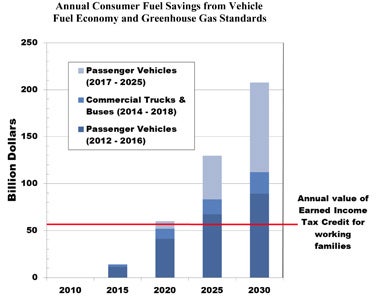(Originally posted yesterday on EDF Voices)
For some time, public health and medical experts have been clear that the Environmental Protection Agency’s air quality standard for ozone, the primary ingredient in smog, isn’t doing enough to protect Americans from serious health risks.
Unfortunately, before EPA even proposed new health standards in response to rigorous science, the American Petroleum Institute (API) attacked with sky is falling claims that 97% of businesses in America would shut down.
This is quintessential beltway politics: fact free and designed to hide the real issues.
As a health scientist, I think the facts matter. And the bottom line is that EPA has a responsibility to adopt health standards anchored in science. So let’s take a closer look at what the science tells us.
Ground-level ozone is the main component of smog and is the single most widespread air pollutant. Ozone is linked to premature deaths, increased asthma attacks and breathing problems, as well as increased emergency room and hospital admissions. This pollutant poses an especially serious risk to children, seniors and people with lung diseases like asthma and bronchitis.
The Science is Sound
The science on ozone’s health effects is rock solid. Evidence from more than 1700 peer-reviewed scientific reports (which continues to be reinforced by new data) clearly shows that our current ozone standard isn’t doing the job of protecting the public health. We need to strengthen that standard.
The Clean Air Scientific Advisory Committee (CASAC) – the body that makes science-based recommendations to EPA – has issued multiple statements indicating that the current ozone standard of 75 parts per billion (ppb) is unacceptable with regard to protecting human health.
And new research, including recent reports demonstrating a significant increase in pulmonary inflammation in healthy individuals exposed to 60 parts per billion (ppb) ozone, supports this analysis and highlights the urgent need for a more health-protective standard.
Need for an Adequate Margin of Safety
By law, EPA must set national health-based standards that protect human health with “an adequate margin of safety.” To do this, the agency considers factors including the nature and severity of the health effects involved, the size of the at-risk populations, and the scientific uncertainties that must be addressed.
How do these factors add up in the case of ozone?
The nature and severity of the health effects involved: It is hard to imagine health effects more severe than death or the inability of a person to breathe without a struggle, especially if it’s a small child who has to be rushed to the emergency room.
The size of the at-risk population: Nearly 34 million Americans have been diagnosed with asthma during their lifetimes and estimates predict that number will grow by more than 100 million by 2025. Nearly 12 million people suffer from chronic obstructive pulmonary disease (COPD), a disease that causes serious, long-term disability and kills more than 120,000 Americans each year. And that’s only a partial list of those at increased risk from ozone.
The degree of uncertainties that must be addressed: Evidence continues to accumulate of effects in healthy people at exposures as low or lower than 60 ppb. Thus, if uncertainty is part of the decision making process, then EPA is obliged to adopt a standard even more protective than the one recommended by CASAC.
Here We Go Again: Unfounded Claims Concerning Economic Impacts
These kinds of sky is falling prognostications are not new. As far back as 1997, when EPA was considering one of the first revisions to the ozone health standard, Senator Spencer Abraham (R. MI) was among many who claimed that the new standards would have devastating economic impacts. “Dry cleaning establishments, hair salons, and other small businesses will not be able to absorb the increased costs imposed by these regulations,” the Senator said.
Those claims proved to be entirely false. In fact, in fact, Texas has made the case that the Gross Domestic Product (GDP) has gone up even as ozone controls strategies have been adopted, resulting in cleaner air across the state.
Old scare tactics die hard. That’s why today API and others are again trying to stop reform of the ozone standards by making the same sort of unfounded claims that all businesses will close the doors. But environmental protection is, or should be, a health issue, not a political football. And it’s on the ground of health that that The American Academy of Pediatrics, the American Medical Association, the American College of Chest Physicians, the American Public Health Association and the American Thoracic Society have all endorsed CASAC recommendations for new ozone standards.
In the end, EPA should not be swayed by “sky is falling” claims, whether from the petroleum industry or any other group. We urge EPA not to delay adoption stricter ozone standards. To do so would be to needlessly threaten the health of millions of Americans.










